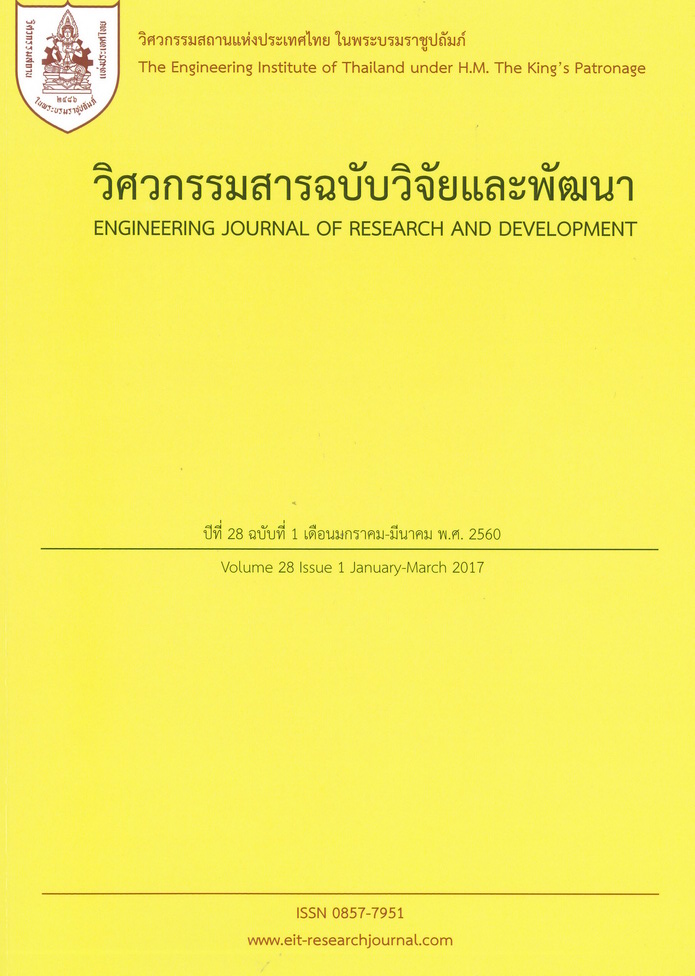อิทธิพลกระแสเชื่อมต้านทานจุดต่อสมบัติของรอยต่อเกยระหว่างอะลูมิเนียมผสมและเหล็กกล้าเคลือบสังกะสี
Main Article Content
Abstract
บทความนี้มีจุดประสงค์ในการศึกษาอิทธิพลของกระแสเชื่อมต้านทานจุดต่อสมบัติรอยต่อเกยระหว่างอะลูมิเนียมผสม AA1100 และเหล็กกล้าเคลือบสังกะสี ผลการทดลองโดยสรุปมีดังนี้ กระแสเชื่อมต้านทานจุดที่ทำให้เกิดความแข็งแรงเฉือนของรอยเกยสูงสุด 2300 นิวตัน ในการทดลองนี้ คือกระแสเชื่อม 95 กิโลแอมป์ เวลากดแช่ 10 รอบ และแรงกด 0.10 เมกะปาสคาล การเพิ่มกระแสเชื่อมส่งผลทำให้ความแข็งแรงเฉือนของรอยต่อเพิ่มขึ้นและเกิดการเพิ่มปริมาณการกระจายตัวของอะลูมิเนียมที่ผิวสัมผัส (Interface) ของรอยต่อ รอยต่อเกยที่กำหนดให้แผ่นเหล็กอยู่เหนือแผ่นอะลูมิเนียมแสดงค่าความแข็งแรงสูงกว่ารอยต่อเกยที่กำหนดให้แผ่นอะลูมิเนียมอยู่เหนือแผ่นเหล็ก ความลึกรอยกดและสัดส่วนระหว่างความลึกรอยกดต่อความหนาของแผ่นงานของรอยต่อมีค่าลดลงเมื่อกระแสเชื่อมเพิ่มขึ้นในรอยต่อแบบที่ 1 และมีค่าลดลงเมื่อกระแสเชื่อมลดลงในรอยต่อแบบที่ 2 โครงสร้างจุลภาคผิวสัมผัสแสดงการก่อตัวของสารประกอบแบบเปราะ FeAl3 และส่งผลทำให้ความแข็งแรงของรอยต่อลดลง
EFFECT OF RESISTANCE SPOT WELDING CURRENT ON LAP JOINTS PROPERTIES BETWEEN ALUMINUM ALLOY AND ZINC-COATED STEEL
This article is aimed to study the effects of resistance spot welding current on AA1100 aluminum alloy and zinc coated steel lap joint properties. The summarized experimental results are as follows. The optimum welding parameters that produced maximum tensile shear strength of 2300 N was a welding current of 95 kA, a holding time of 10 cycles, and a welding pressure of 0.10 MPa. Increasing of welding current, increased the tensile shear strength of the joint and also increased the amount of aluminum dispersion at the joint interface. The lap joint of steel over the aluminum (Type I) showed the higher joint tensile shear strength than a lap joint of aluminum over the steel (Type II). The indentation depth and the proportion of the indentation depth and the plate thickness decreased when the welding current was increased in the type I lap joint and was decreased in the type II lap joint. The interface structure showed the formation of the brittle FeAl3 intermetallic compound that deteriorated the shear strength.
Article Details
The published articles are copyright of the Engineering Journal of Research and Development, The Engineering Institute of Thailand Under H.M. The King's Patronage (EIT).

